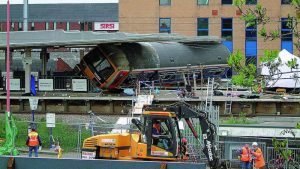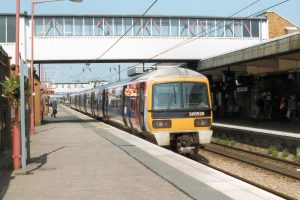Introduction
On the fateful evening of May 10, 2002, a routine commuter train journey turned into a nightmare for passengers on a West Anglia Great Northern service traveling through Potter’s Bar, Hertfordshire, United Kingdom. The Potter’s Bar derailment not only resulted in loss of lives but also raised questions about rail safety and infrastructure maintenance. This tragic incident left a lasting impact on the nation’s transportation system and sparked debates about the need for comprehensive safety measures.
The Incident

The ill-fated train, a four-carriage West Anglia Great Northern service, was en route from London King’s Cross to King’s Lynn. As it approached Potter’s Bar station, disaster struck. At approximately 12:45 pm, the rear carriages of the train derailed, colliding with the station platform and an overhead road bridge. The force of the impact caused significant damage, resulting in chaos and panic among the passengers.
Casualties and Injuries
The immediate aftermath of the Potter’s Bar derailment was marked by tragedy. Seven people lost their lives, and many others sustained injuries of varying degrees. Emergency services rushed to the scene to rescue survivors and provide medical assistance. The impact on the local community was profound, as the incident unfolded in a busy residential area, highlighting the potential risks associated with railway accidents in populated zones.
Investigation and Findings
In the wake of the Potter’s Bar derailment, an extensive investigation was launched to determine the root cause of the incident. The focus turned to the state of the rail infrastructure and the maintenance practices in place. The inquiry, led by the Health and Safety Executive (HSE) and the British Transport Police, revealed a concerning discovery.

The immediate cause of the derailment was identified as a set of faulty points – the mechanisms that enable trains to switch from one track to another. A fastening mechanism, known as a stretcher bar, had fractured due to a combination of factors, including design flaws and substandard welding. This failure caused the points to move unexpectedly, leading to the derailment.
Maintenance and Oversight Issues
The investigation not only exposed the specific technical failures but also shed light on broader issues related to railway maintenance and oversight. It was revealed that the maintenance work on the points had been subcontracted to a private engineering firm, Jarvis Rail. The inquiry found deficiencies in the quality of the maintenance work and insufficient supervision by both Jarvis Rail and Railtrack, the infrastructure owner at the time.
The Potter’s Bar derailment raised questions about the privatization of rail services in the UK and the potential conflicts of interest that could arise when profit-driven companies are entrusted with critical safety-related tasks. The incident underscored the importance of robust regulatory oversight and accountability in ensuring the safety of the rail network.
Reforms and Safety Measures
In the aftermath of the Potter’s Bar tragedy, significant reforms were implemented in the UK’s railway industry. Railtrack, the company responsible for track maintenance, underwent restructuring and was eventually replaced by Network Rail in 2002. This shift aimed to bring a stronger focus on safety and accountability within the industry.
Additionally, the investigation prompted a review of rail maintenance practices and highlighted the need for more stringent quality control measures. The Rail Safety and Standards Board (RSSB) played a crucial role in developing new guidelines and standards to enhance the safety of railway infrastructure.
The Potter’s Bar derailment of May 2002 remains etched in the collective memory of the UK as a stark reminder of the importance of maintaining rigorous safety standards in the railway industry. The tragic incident prompted a reevaluation of maintenance practices, regulatory oversight, and the role of private companies in ensuring the safety of the nation’s rail network. The reforms that followed sought to address the shortcomings exposed by the Potter’s Bar derailment, with the goal of preventing similar tragedies in the future.



